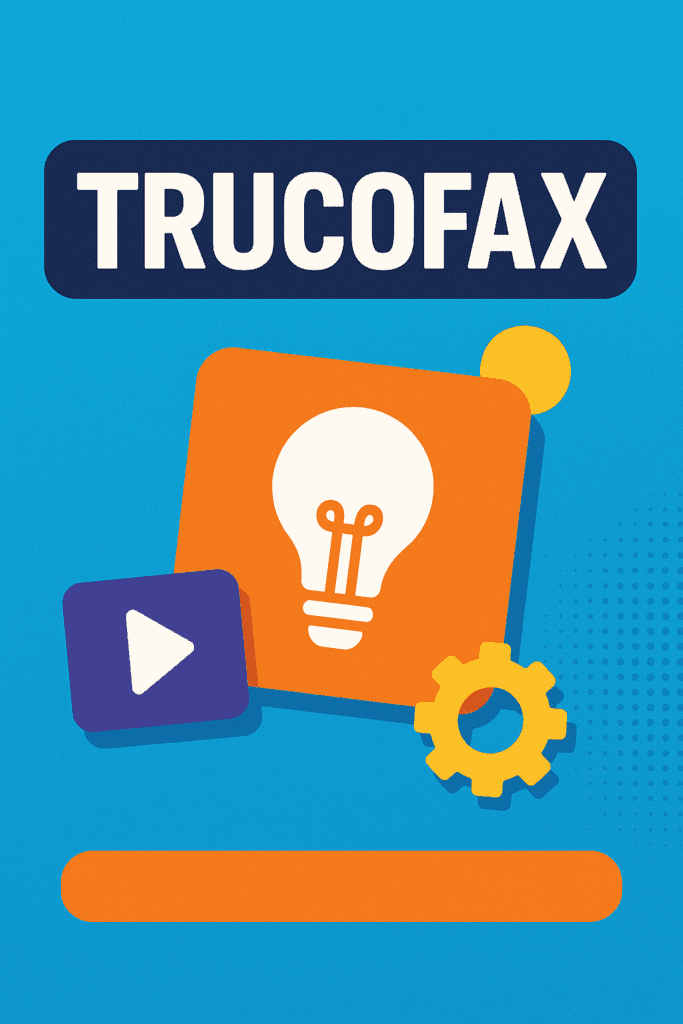If you’re seeing the word “Trucofax” everywhere and wondering, okay but what is it, exactly?, you’re not alone. The term’s new, a little slippery, and depending on which article you click can mean a few different things. That’s precisely why searchers bounce around trying to get a clean answer.
Here’s the straight take, pulling from what’s ranking right now and cross-checking it with established online-fax providers so you can actually make decisions.
First What Does “Trucofax” Mean?
- As a modern, cloud-based faxing tool (send/receive faxes online, encryption, email-to-fax, mobile apps). Several pieces describe Trucofax like a next-gen fax service: cloud delivery, document conversion, tracking, and integrations basically “fax without the machine.”
- As a general “information hub” / “truth-first” platform (curated facts, summaries, credibility filters). A handful of articles frame Trucofax as a fast, verified info delivery tool or methodology rather than a fax product.
- As an emerging buzzword (even used for “clever facts” content). A few posts treat it like an internet trend a catchy label for bite-size tips or “true facts.” That’s more cultural than technical.
Quick reality check
Because “Trucofax” is new (and a bit all over the place), the safest search-intent match for business users is the cloud fax interpretation. Why? It answers concrete queries people actually have: How do I send a fax online? Is it secure? HIPAA-compliant? How much does it cost? That’s also where we can benchmark against reputable incumbents like eFax, Fax.Plus, and HelloFax to set expectations.
So, in this guide, I’ll treat Trucofax as a modern digital fax platform—then I’ll note the other meanings where useful (content method / info hub), since some readers might land here with that in mind.
Trucofax (as a Cloud Fax Service): What It Should Do in 2025
Let’s outline what a legit “Trucofax-style” platform should offer based on industry standards you’ll see at the leaders:
- Online faxing from any device (web app, mobile app, email-to-fax). No physical machine, no phone line.
- Security + encryption in transit and at rest, plus access controls and audit trails. (If you handle PHI or legal docs, you need this.)
- Compliance options (HIPAA / HITRUST for healthcare, SOC/ISO controls for enterprises, GDPR considerations if you operate in the EU).
- Numbering & portability (keep your fax number, get local/toll-free numbers, port existing lines).
- Integrations (Gmail, Microsoft 365, Google Drive/Docs, Dropbox, Box, APIs for EHR/CRM/ERP).
- Delivery receipts & dashboards (real-time status, resends, failure alerts).
- Team management (multi-user routing, permissions, SSO/SCIM for bigger orgs).
- Scalability (burst capacity, queueing, reliability SLAs).
If a service calling itself “Trucofax” can’t tick most of those boxes, you’re probably looking at a content site or a buzzword page not an enterprise-grade fax product.
Who Actually Needs a Trucofax-Type Service?
Healthcare (HIPAA-friendly faxing)
Hospitals, clinics, labs, dental practices still faxing due to interoperability and legal comfort. A cloud fax that supports HIPAA/HITRUST and BAA agreements is essential. eFax Corporate, for instance, highlights compliance pathways and enterprise security features commonly required by providers.
Legal & Financial Services
Law firms and regional banks move time-sensitive, confidential docs. They need encryption, audit trails, and retention and the ability to fax from Outlook or a DMS. (eFax references case studies; Fax.Plus leans heavily on enterprise security and SSO.)
Government & Education
Public agencies and universities often keep fax in the loop for legacy process reasons. A cloud fax lets them meet policy requirements without maintaining brittle phone lines or copier-fax combos.
SMBs That “Sometimes Have to Fax”
If you only fax a few times a month but can’t escape it (insurance claims, supplier agreements), you want pay-as-you-go or a light plan no boxes, no toners, no headaches. (HelloFax positions itself squarely here—simple, email-to-fax, cloud storage tie-ins.)
How Trucofax (Cloud Fax) Typically Works Start to Finish
Not “my personal story,” to be transparent—but a composite walkthrough of what small teams actually do when they modernize fax. If I were implementing this for a lean team, I’d run it like this:
- Pick a plan & number
Choose local/toll-free or port your existing number to avoid changing forms and business cards. (Providers handle porting; no downtime if planned correctly.) - Set up users & routing
Create user accounts, assign permissions (who can send, who can only view), and route inbound faxes to shared mailboxes (e.g., billing@ or referrals@). - Enable email-to-fax
Train staff: compose an email, attach PDF, send to faxnumber@<service>.com. That’s it. (Most teams love this because it’s muscle memory.) - Add integrations
Connect to Google Drive, Box, OneDrive for archival; use API for higher volume or EHR/CRM hooks. - Lock down security
Enforce strong passwords/SSO, enable multi-factor authentication, limit who can export/download, and turn on admin logs. - Test deliverability & failovers
Send test faxes to oddball numbers (older machines, international lines). Configure retry logic and ensure delivery receipts reach the right inbox. - Document your SOP
Write a one-page “How we fax” with screenshots. Nobody reads manuals, but they will read a 1-pager taped near the reception desk.
Cost Reality: What Should a “Trucofax” Plan Cost?
Every provider prices differently, but here’s the general pattern:
- Light usage (solo/SMB): $10–$25/mo for a few hundred pages, email-to-fax, basic storage.
- Team plans: $25–$60/mo with multiple users, better analytics, priority support.
- Enterprise: Custom quotes with SSO/SCIM, advanced compliance, API throughput, BAA, dedicated account management.
You can benchmark against eFax, Fax.Plus, HelloFax, and MetroFax to figure out if a “Trucofax” quote is fair. (MetroFax may redirect based on region; they often point to eFax.)
Pro tip: If you fax in bursts (e.g., end-of-month claims), ask sales about overage rates and burst capacity. That’s where bills creep up.
Security, Compliance, and “Is This Actually Safe?”
Short answer: it can be. But verify.
- Encryption: TLS in transit, AES at rest.
- Access controls: admins can revoke users, set roles, require MFA.
- Audit logs: who sent what/when, delivery confirmations.
- Compliance posture: If you’re in healthcare, you’ll want a HIPAA-aligned plan (with a signed BAA). eFax Corporate publicly foregrounds HIPAA/HITRUST; Fax.Plus lists HIPAA-compliant options and enterprise security. If a vendor that calls itself Trucofax can’t articulate this, pause.
Where the Term Gets Fuzzy (and How to Handle It)
As mentioned, some sites pitch “Trucofax” as a “truth-first” information method a way to gather credible sources and deliver concise summaries, almost like a smart news hub. If that’s what you were after, those articles describe it as a fact-checking / curation framework rather than a fax tool.
Practical tip: Whether you mean cloud fax or curated facts, you’re chasing trust and speed. In business contexts today, both matter secure transmission for documents, and credible, digestible information for decisions. That’s probably why the keyword is blowing up: it pulls traffic from two adjacent needs (secure docs + trustworthy info).
Trucofax vs. Established Providers (eFax, Fax.Plus, HelloFax)
If you’re evaluating a newcomer (or a page using the name), compare it to these baselines:
- eFax (Corporate/Enterprise)
Emphasis on compliance, enterprise features, case studies. API options, admin controls, and reliability for regulated industries. - Fax.Plus
Strong security features, HIPAA-compliant plan, SSO/SCIM, and broad platform support (web, mobile, email-to-fax). Good for SMB Enterprise. - HelloFax
Simple and friendly for small teams. Tight integrations with Google Drive/Docs/Dropbox/Box. Great if you want minimal setup and light traffic.
If a “Trucofax” product claims parity, it should offer comparable encryption, compliance pathways, integrations, and support.
Real-World Use Cases (with sample workflows)
A clinic that still gets referrals by fax
- Route a dedicated number to referrals@clinic (shared inbox).
- Staff uploads PDFs from the EHR, sends via email-to-fax to hospitals.
- Admin exports delivery logs monthly for audit.
A supplier needing signed POs from older partners
- Sales sends signed PO PDFs with a cover sheet.
- The platform retries busy lines automatically; logs success/failure.
- Finance reconciles delivery receipts with invoice dates.
A law firm that wants remote-friendly faxing
- Attorneys fax from Outlook; paralegals see the shared queue.
- Everything is archived to OneDrive with retention rules.
- Firm owners review admin logs quarterly.
Common Gotchas (and how to dodge them)
- Page limits & overages: Heavy scans (photos) balloon “pages.” Compress PDFs before sending.
- Number porting delays: Start the port early; keep the old line active until cutover.
- Spam filters on receipts: Safelist the provider’s email domain so delivery confirmations don’t vanish.
- International quirks: Test to a few different country codes. Fax is… vintage. Some routes still behave like it.
If You Meant the “Information Hub / Truth-First” Version of Trucofax
A small slice of readers land here asking: Is Trucofax a news tool? Some articles describe it as a centralized information hub with a “fact-first” approach verified sources, faster summaries, and shareable briefs. That’s intriguing if you’re building executive briefings or marketing content that needs fast accuracy.
How to apply that idea today (without a specific product):
- Build a shared research doc with source tiers (primary docs, official data, top-tier media).
- Adopt a summary template (What’s new Why it matters Action items).
- Track provenance (link to source, date accessed).
Think of it as the “Trucofax method”: clean facts, fast delivery, repeatable format.
Decision Checklist (Copy/Paste This)
- Do I need secure online faxing or a fact-curation workflow?
- If it’s faxing, does the vendor offer encryption, receipts, and number porting?
- If we’re regulated, can they sign a BAA and show HIPAA/HITRUST posture?
- Do we need SSO/SCIM, team roles, and API integration?
- What’s the true monthly volume and expected burst? (Ask about overages.)
- Where will we store archives Drive, OneDrive, Box? Are there retention rules?
FAQs
Q1: Is Trucofax a real product or just a buzzword?
Both show up in SERPs. Some pages pitch Trucofax as a cloud fax; others use it as an info-hub / “truth-first” idea. If you’re buying software, vet it like you would eFax or Fax.Plus feature-by-feature.
Q2: Is online faxing legal and compliant for healthcare?
Yes if you choose a plan that supports HIPAA/HITRUST controls and sign a BAA. Established providers document this publicly.
Q3: Can I fax from Gmail or Outlook?
Yep. Most modern providers support email-to-fax and add-ons for cloud storage.
Q4: What file formats work best?
PDF is your friend. Keep scans clean and compressed so page counts (and costs) don’t spike.
Q5: What if I only fax once a month?
Pick a low-tier plan or pay-as-you-go. Don’t overbuy capacity you won’t use.
Q6: We tried another service and had delivery issues. What now?
Test multiple destinations (domestic/international), check retry settings, confirm SPF/DKIM on receipt emails (so confirmations aren’t filtered), and talk to support about route optimizations.
Conclusion
- If you came here asking “what is Trucofax?”, the most practical interpretation for business users is a secure, cloud-based fax platform. Use the checklists above and benchmark features against eFax, Fax.Plus, and HelloFax.
- If you meant “Trucofax” the information method, borrow the mindset: fact-first inputs, fast summaries, tight sourcing. That’s useful for internal briefings and content teams alike.
Either way, the common thread is trust + efficiency. Secure document transmission and credible information aren’t luxuries anymore they’re the baseline for moving fast without breaking things.
Get Updates on Our Tech Insights.



